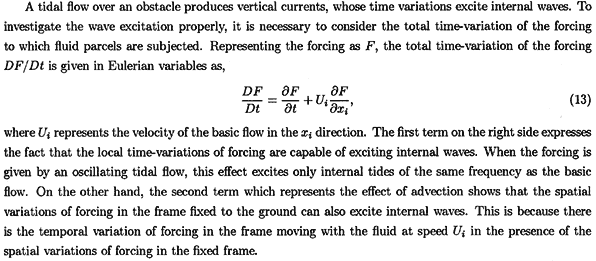The amplitudes of these cells are larger than those in the M2 case, since the barotropic flow is stronger for the K1 case. Therefore, their effect on mixing is expected to be more vigorous and confined near the sill region than in the M2 case.
Next, we direct our attention to intense smaller-scale disturbances detected in Fig. 3. These short waves may cause considerable mixing, because shorter wavelengths are favorable for inducing stronger dissipation and so releasing energy for mixing, and because the occurrence of wave breaking requires smaller amplitude for waves of shorter wavelength. Small-scale disturbances are labeled as A1, B1 , A2 , B2, a1, and b1 from left to right, with the tidal period during which they are produced indicated by subscripts and with the direction of the tidal flow at the time of their production indicated by capital (rightward) and small (leftward) letters. At the sill top, rightward flow produces A2 and B2. The leftward flow in the last half period produced a1 and b1 which are now on the right side of the sill, whereas A1 and B1 were produced by rightward flow in the previous period. These small-scale disturbances are clearly distinguished, as sill-scale cells disappear after 1.5 periods. While B2 stays at almost the same place, A1, B1 , and A2 move leftward, and a1 and b1 move rightward, being gradually dispersed. In the next half period, a2 and b2 are produced by leftward flow and stay around the sill top until the end of the flow, in which B2 at the sill top is superposed on a2 and b2.
The moving speeds of these small-scale disturbances estimated from Fig. 3 (0.3 〜 1.4ms-1) are different from the tidal flow speed (less than 0.125ms-1 in the deep water region). This fact means that they are freely-propagating internal waves. Thus, their frequencies must be larger than the inertial frequency, despite that the K1 frequency is subinertial. Furthermore, these features produced by rightward (leftward) flow propagate leftward (rightward), indicating that they propagate only in the upstream direction as determined at their generation time. This is also inconsistent with the character of internal tides which propagate in both directions. Therefore, previous theoretical models cannot explain the generation and propagation of such intense short waves, because these models assumed that an oscillating tidal flow over topography can excite only internal tides. From these considerations, it is inferred that intense short waves in our model could represent another class of waves. In fact, the above two qualities are characteristics of lee waves, and thus we reinvestigate the excitation mechanism of internal waves by a tidal flow in the next section, to show that unsteady lee waves (which are capable of propagating away) can be excited by an oscillating flow.
3.3 Excitation mechanism of unsteady lee waves
